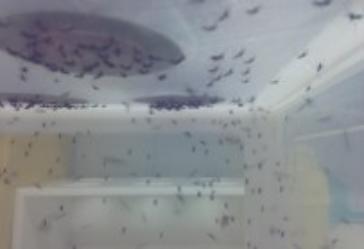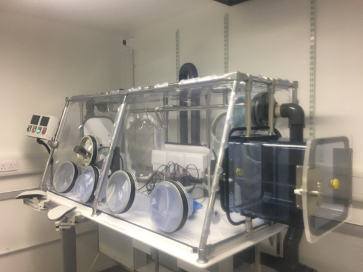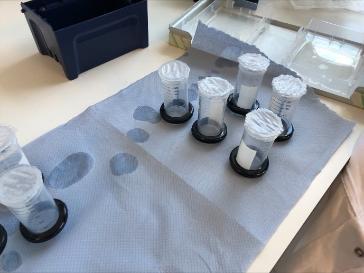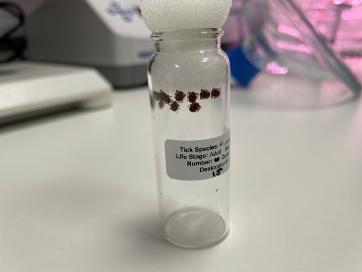Insectaries
The CVR houses state-of-the-art insectaries, which are specialist facilities enabling us to safely keep and study arthropods such as mosquitoes and ticks which are important vectors of disease.
Approximately 30% of all infectious diseases that emerged in the last decade are caused by arthropod-borne viruses (arboviruses). Arboviruses are transmitted by biting arthropods like mosquitoes, midges and ticks.
The insectaries provide vital facilities for research which helps us to better understand the mechanisms of how arthropods get infected by arboviruses as well as how they further transmit them to humans. Ultimately, this will enhance our understanding of disease emergence and benefit the development and application of vector control strategies to block arbovirus transmission.
We have insectaries at containment levels (CL) 2 and 3, which are used to safely rear and infect arthropods with viruses classified into different Hazard groups.
Mosquitoes
The insectaries enable us to rear and infect living mosquitoes such as Aedes aegypti, a significant vector of a number of important viruses.

Females from many mosquito species, such as Aedes aegypti, must get a blood meal from a vertebrate host to obtain the necessary proteins to develop their eggs. When they feed on blood the mosquitoes can get infected with arboviruses such as Zika and dengue viruses from the host they feed on and transmit them to a new host during subsequent bites, hence acting as a vector. Arboviruses transmitted by mosquitoes represent global public health threats and economic burdens. To fight against arbovirus transmission, the control of mosquito vectors remains the most effective way. This can be achieved by replacing mosquitoes susceptible to infection by resistant ones. To successfully develop such strategies, it is necessary to get a deep understanding of the factors that influence mosquito vector competence, which is the mosquito’s ability to get infected following an infectious blood meal and transmit the pathogen to a new host.

Our research is helping us to better understand the mechanisms by which mosquitoes get infected by pathogens and further transmit them, and the factors that influence this - such as mosquito innate antiviral immunity, physiology, symbionts and gene expression regulation.
Using these specialist facilities, we can safely infect mosquitoes with different viruses by giving them infectious blood meals. This then enables us to further analyse different aspects of infection in the mosquitoes, such as virus tropism, tissue-specific immune responses, and the role of specific genes in transmission. It also helps us to explore the mechanism and efficacy of transmission-blocking symbionts such as Wolbachia.
For research on mosquito-virus interactions, we use the following insectaries:
CL2 Insectaries: Used for rearing and research involving non-infected mosquitoes.
CL2 Infection Insectaries: Used for infection with Hazard group 2 arboviruses (e.g. Zika, Semliki Forest, Bunyamwera viruses), as well as rearing and research involving infected mosquitoes.
CL3 Infection Insectaries: Used for infection with Hazard group 3 arboviruses (e.g. dengue and chikungunya viruses), as well as rearing and research involving infected mosquitoes.

Research groups studying interactions between mosquitoes and arboviruses:
Kohl group
Ticks
We have recently introduced tick colonies into our insectaries. The research this enables us to do will enhance our understanding of how viruses are transmitted by ticks.

After hatching from eggs, ticks need to feed on blood at every life cycle stage to survive. It is during this blood feeding that the ticks can infect the host with virus. In the Insectaries we can safely infect ticks with virus, and then monitor what the virus does within the ticks.
Our research is focussed on a specific group of emerging viruses called phenuiviruses, and the main virus we currently work on in the insectaries is Uukuniemi uukuvirus (UUKV). We keep three species of ticks in the insectaries: Ixodes ricinus, Haemaphysalis longicornis and Rhipicephalus sanguineus, all of which are known vectors for phenuiviruses.
Tick-borne phenuiviruses represent a growing threat to humans globally. Viruses within this group range in pathogenicity quite markedly from severe fever with thrombocytopenia syndrome virus (SFTSV) which causes haemorrhagic fever and a case fatality rate of approximately 20%, to UUKV which is thought to cause asymptomatic infection in people. UUK is a good robust, safe model which we are using to study the more pathogenic members of this group of viruses.

For research on tick-virus interactions, we currently use the following insectaries:
CL2 Insectaries: Used for rearing and research involving non-infected lab reared ticks.
CL2 Infection Insectaries: Used for infection with Hazard group 2 arboviruses (eg. UUKV), as well as rearing and research involving infected ticks or ticks that have been caught from field sites within the UK or abroad.
The Brennan research group study interactions between ticks and arboviruses.

